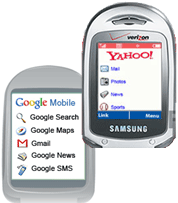m-commerce
By Jaco Grobbelaa on Thu, Jun 16, 2011 @ 11:50 PM

Anything new winds up with an abbreviated name. Electronic mail became email. The latest abbreviation is m-commerce. Can you guess what that stands for?
If you guessed mobile commerce, you are on top of things. There are going to be more smart phones sold this year than computers. For one thing they are much cheaper if you take a phone carriers deal. They get you onto the internet. Finally smart business men are using m-commerce to make the sale so you can shop online.
Lets look at this in terms of exact numbers. More than 200 million people worldwide access Facebook through their mobile devices, and people who do this are twice as likely to be active on Facebook than non-mobile users. Mobile/social apps like Foursquare and shopkick are catching on. It appears that social media and mobile tech may be a good match.
For example, Tee shirt e-retailer (another abbreviation) Threadless creates shirts based on designs voted on by Threadless community members. In other words you get to vote for your favorite design and your design might win. Threadless is working to capitalize on the m-commerce trend by launching a mobile-optimized version of its website.
M-commerce not only makes browsing, searching and buying easier, it also encourages people rating the tees, sharing designs and blogging. The products at Threadless are driven by the community of customers, who not only buy the tees, but can design their own and offer them for sale on the site. Customers can rate the tees and share product pages by way of built-in links to various social media.
Threadless runs a banner across the top of every page of the m-commerce site that says, Were mobile now! Shop on your fancy phone and get 20% off.
They say that having a mobile-optimized site in the face of increasing traffic from devices running on different mobile operating system reduces bounce rates and speed page load times.
What exactly is a bounce? A visitor bounces when he arrives on a page on a site and then immediately leaves. Non-optimized sites are ones where the image refuses to download. This is considered one of a number of content errors. Another has to do with how long it takes the page to load. If it takes too long, the customer is going to leave the site and go elsewhere. Content errors can have a negative impact on site performance. People cant buy from a page that will not load on their smart phone, whatever kind it is.
Some of these problems exist on the internet, but have become more obvious on the different platforms of smartphones. All this is a part of the new word and new world of m-commerce.
Related articles
- 10 Tips for Optimizing Your Mobile Site (thesearchagents.com)
- How Fashion Retailers Are Redefining E-Commerce With Social Media (mashable.com)
Share this
You May Also Like
These Related Stories
Alexa or No Alexa--That Is the Question


Alexa or No Alexa--That Is the Question
Sun, Sep 11, 2011 @ 07:28 PM
4
min read
Can You Stick Your Landing Pages?


Can You Stick Your Landing Pages?
Mon, Jun 20, 2011 @ 01:06 AM
2
min read
A Responsive Website Is Not Optional For Affordable SEO


A Responsive Website Is Not Optional For Affordable SEO
Wed, Mar 15, 2017 @ 09:00 AM
2
min read
.png?width=302&height=75&name=BVM%20Logo%20-%20transparent%20(1).png)



No Comments Yet
Let us know what you think